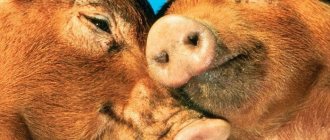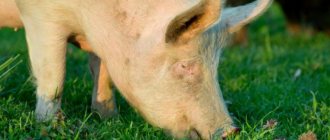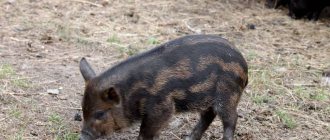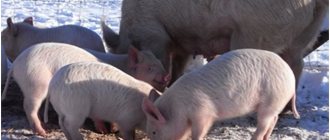African swine fever (lat. Pestis africana suum; abbr. ASF), African fever, East African plague, Montgomery disease is a highly contagious viral disease of pigs, characterized by fever, cyanosis of the skin and extensive hemorrhages in the internal organs.
Belongs to list A according to the International Classification of Contagious Animal Diseases. African swine fever is not dangerous to humans.
In 2007, numerous outbreaks of ASF were recorded in Georgia. Since 2007, ASF continues to spread among wild boars and domestic pigs in the European part of Russia.
Until 2011, the plague was found in the North Caucasian Federal District and Southern Federal District, and in 2012-2013 it spread to the territories of the Central Federal District and Northwestern Federal District. Belarus and Ukraine are under threat from the development of epizootics.
In total, more than 500 outbreaks of the disease were recorded in Russia, economic losses exceeded 30 billion rubles, and about a million animals were destroyed.
In 2021, an outbreak of ASF in the Belogorsk region of the Republic of Crimea. Also in July 2021, an outbreak of ASF occurred in the Omsk region. In November 2021, an outbreak of ASF was registered in the Kaliningrad and Tyumen regions.
Causes and distribution
Under natural conditions, domestic and wild pigs of all ages are susceptible to African swine fever. All wild African pigs are susceptible to the virus but do not show clinical signs of disease.
River pigs and giant forest pigs are infected with ASF virus, but the extent of infection and their role in the epidemiology of the disease are unknown.
European wild boar are susceptible to ASF, with mortality rates similar to domestic pigs. Certain indigenous pig populations in central Africa have a higher ability to survive ASF outbreaks.
The source of the infectious agent is sick animals and virus carriers. Infection of healthy pigs occurs when they are kept together with infected virus carriers.
Pigs remain infected for several months but only shed the virus for 30 days. The virulent virus resides only in the lymph nodes for a long time; it is contained in other tissues for 2 months after infection.
Factors of transmission of the pathogen are food, pastures, vehicles contaminated with secretions of sick animals.
The use of non-neutralized table waste in feed contributes to the spread of the pathogen.
Mechanical carriers of the virus can be birds, people, domestic and wild animals, rodents, skin parasites (some types of ticks, zoophilic flies, lice) that have been in contact with sick and dead pigs.
The reservoirs of the virus in nature are African wild pigs and ticks of the genus Ornithodoros.
In the sylvatic cycle between warthogs and the argasid tick Ornithodoros moubata, transmission occurs from argasid ticks to newborn warthogs, among the ticks themselves, and from ticks to domestic pigs.
General characteristics of the disease
African plague is also known as Montgomery disease, named after the researcher who proved its viral nature. This is an infectious process in which inflammatory processes develop, fever occurs, and the blood supply to internal organs stops.
In individuals who die from this disease, the following pathological changes in the body are observed:
- multiple connective tissue lesions;
- numerous sources of hemorrhage;
- severe pulmonary edema;
- an increase in the size of the spleen, kidneys, and liver glands;
- serous-hemorrhagic fluid in the respiratory system and stomach;
- content of blood clots in the lymph.
The virus that causes this serious disease is resistant to external conditions. It survives temperature changes and reproduces during drying, crystallization and rotting. The virus is also resistant to formaldehyde and alkaline conditions, but is sensitive to acids.
This virus can survive in pickles and smoked meats for several weeks or months. It remains active in feces for about 160 days, and in urine for up to 60 days. The virus can survive in soil for 180 days, in bricks and wood - from 120 to 180 days. In meat it remains for about 5-6 months, in bone marrow - up to 6-7 months.
The first case of this terrible disease was recorded in 1903 in South Africa. The infectious process spread to wild boars. The disease subsequently spread to many African countries in the southern part of the Sahara.
In the mid-twentieth century, a case of African plague was recorded in Portugal. This happened after meat products from Angola were brought into the country. Subsequently, the infectious process spread to the territories of Spain, Cuba, France, Holland, and Malta.
Statistics on outbreaks of African plague by year are as follows:
- Kenya - 1921;
- Portugal - 1957 and also 1999;
- Spain - 1960;
- France - 1964, as well as 1967 and 1974;
- Italy - 1967, 1969, 1978-1984 and 1993;
- Cuba - 1971;
- Malta - 1978;
- Dominican Republic - 1978;
- Brazil - 1978;
- Belgium - 1985;
- Holland - 1986;
- Russia - 2007;
- Georgia - 2007;
- Armenia – 2007.
The plague was brought to Russia from Georgia. In turn, this virus spread in Georgia due to the misuse of waste from international ships that transported contaminated meat and meat products. The media reported that the corpses of dead animals in this country were found in ordinary landfills, river banks and on the sea coast.
In areas that are considered stationary unaffected by African swine fever, there is a periodicity of outbreaks: in Africa this viral process is observed every 2-4 years, in Europe – every 5-6 years.
Pathogenesis
Pigs become infected through nutritional and aerogenic routes, through damaged skin and conjunctiva. The virus infects macrophages and thus modulates the transcriptional activation of free genes for the body's response.
Reproduction of the virus occurs in the lymphoid and myeloid tissues of the immune system, endothelial cells of blood and lymphatic vessels, macrophages of the mononuclear phagocyte system.
Reproduction of the virus is accompanied by a cytopathic effect on lymphocytes, macrophages and endothelial cells.
Due to necrosis of the endothelium of blood vessels, mucoid and fibrinoid swelling and fibrinoid necrosis develop in their walls.
As a result, the permeability of the vascular walls sharply increases, venous and inflammatory hyperemia, thrombosis, and massive hemorrhages appear in the mucous and serous membranes, skin and parenchymal organs.
In the organs of the immune system - lymph nodes, spleen, bone marrow, as a result of the cytopathic effect of the virus, extensive necrosis of lymphoid and myeloid tissues, macrophages is observed, which leads to leukopenia and a sharp weakening of antiviral immune mechanisms (immunodeficiency) and death.
Pathological changes
Numerous hemorrhages are detected in the skin, mucous and serous membranes. Lymph nodes (especially gastric, hepatic, mesenteric, renal) are enlarged 2-4 times, soft, dark red on the outside and on the cut, sometimes the cut surface has a marble pattern.
In the chest and abdominal cavities there is a yellowish serous-hemorrhagic exudate mixed with fibrin and sometimes blood. Internal organs, especially the spleen, are enlarged, with multiple hemorrhages.
Course and symptoms
The incubation period of the disease depends on the number of virions entering the body, the condition of the animal, the severity of the disease and can last from 2 to 6 days.
The course is divided into fulminant, acute, and less often chronic. The disease progresses: hyperacutely (2-3 days), acutely (7-10 days) and less often chronically (2-10 months).
In lightning-fast flows, animals die without any signs; in acute cases, the animals’ body temperature rises to 40.5–42.0 °C, shortness of breath, coughing, attacks of vomiting, paresis and paralysis of the hind limbs appear.
Serous or mucopurulent discharge from the nose and eyes, sometimes diarrhea with blood, and more often constipation are observed.
Leukopenia is observed in the blood (the number of leukocytes decreases to 50-60%). Sick animals lie down more, buried in the bedding, rise sluggishly, move around and get tired quickly.
Weakness of the hind limbs, unsteadiness of gait, head down, tail untwisted, and thirst are noted. Red-violet spots are noticeable on the skin in the area of the inner thighs, on the abdomen, neck, and at the base of the ears; when pressed they do not turn pale (pronounced cyanosis of the skin).
Pustules may appear on delicate areas of the skin, in their place scabs and ulcers form. Pregnant sick uteruses abort.
Mortality, depending on the course, can reach from 50 to 100%. Animals that have recovered and survived become lifelong virus carriers.
So:
Signs of African swine fever:
- a sharp increase in temperature to 41.5–-42 degrees;
- enlargement of regional lymph nodes;
- loss of appetite, refusal of feed;
- paresis, paralysis of the hind limbs;
- violation of digestive processes (constipation, diarrhea with blood impurities);
- anemia, cyanosis (cyanosis) of the mucous membranes;
- difficulty, shallow breathing, shortness of breath;
- subcutaneous swelling, bruising in the subcutaneous tissue;
- sudden death of animals;
- pneumonia.
Sick animals look apathetic and literally weaken before our eyes. Pigs have a hard time getting to their feet.
Coordination of movements is impaired; even after the slightest activity, infected animals quickly get tired. When palpating the lymph nodes, severe pain is noted. Appetite is reduced or absent altogether.
A characteristic symptom that manifests itself in pigs infected with African mumps fever is the appearance of dark purple spots with a red tint on the inner surface of the thigh, abdomen, neck, limbs, sides, back, snout, and at the base of the ears.
Classic swine fever
Classic plague is an infectious viral disease that can occur in acute, subacute and chronic forms. Almost all varieties of domesticated pigs and some wild ones are susceptible to infection. The plague affects both mature individuals and piglets. Scientists believe that the causative agent of the disease is a togavirus containing RNA. When introduced into a pig’s body, the virus tends to concentrate in some organs (lymph, bone marrow, liver, blood vessels), as a result of which their walls become thinner, which in turn causes hemorrhages and inflammatory reactions. The incubation period lasts from 5 to 10 days.
Symptoms of CSF
Signs of CSF infection vary depending on the form of the disease. In the hyperacute course of the disease (typical of piglets), the most characteristic indicator is vomiting. There is also a rise in body temperature and the appearance of bright red spots. Animals die very quickly, within just a few days.
In the acute form of the disease, death usually occurs after a week. A signal of infection can be fever in the initial stage of the disease, constipation, which is then replaced by diarrhea, inflammatory processes in the eyes and nose, subcutaneous hemorrhages, and the presence of yellow pustules. Before death, the animal often falls into a coma.
In the case of a subacute course of the disease, the pig sharply loses weight, diarrhea, cough and purulent lesions of the eyes and nose appear. The illness can last about three weeks. The chronic form affects those animals that were able to survive the disease (most often in a subacute form). In this case, various symptoms (fever, cough, inflammation) may appear sporadically.
Ways to fight
Even today, swine fever, unfortunately, cannot be cured. Therefore, the most important way to avoid a CSF epidemic is its prevention. The most effective method is vaccination, which must be done annually. In addition to vaccination, other protective measures should be taken. All newly arrived pigs on the farm must undergo a strict month-long quarantine, and only then join the main herd. Bedding material and transport for animals, equipment used on the farm and even staff clothing should be regularly disinfected. It is also recommended to disinfect food and food
It is important to carry out timely destruction of rodents on the farm so that they do not become carriers of the virus
If the plague has been detected, then the sick individuals are subject to slaughter, and a quarantine is imposed on the farm, which should last 40 days after the death of the last affected animal. After quarantine, all premises and objects that came into contact with sick pigs must undergo thorough disinfection.
Atypical form of ASF
Symptoms vary for each individual infected individual, which is explained by mutation of the virus. ASF can also occur in an atypical form, in which pigs suffer from profuse diarrhea and variable fever.
There are noticeable bruises on the ears, tail, limbs, snout, and body. Animals become weaker, lose weight, and do not gain weight. The skin is covered with wrinkles and very compacted.
Signs of conjunctivitis and gastroenteritis are clearly visible. The infection ends in death, usually on the third day after the first symptoms appear. The mortality rate is 30–65%.
The atypical form of ASF is most often diagnosed in suckling piglets that were weaned early from the sow, in young animals that had contact with virus carriers or were infected with weakly virulent strains of the virus.
However, some piglets recover without treatment. The rest die or are lifelong virus carriers. The disease can be complicated by secondary infections.
Research into the danger of the virus to humans
Not all scientists are so optimistic; various studies have been conducted that have alarming conclusions about the effects on humans. Despite the absence of disease in humans from the virus, there are documented responses to the production of antibodies against it. This indicates entry and an attempt to infect the body.
ASF virus research
Scientists have conducted research and report the discovery of new sequences of viral origin in human blood. They are directly related to aspharoviruses (the only representative of the ASF group). This indicates greater genetic diversity of the virus than previously known.
It is also noted that no one has conducted massive research to search for the ASF virus in people, since there are simply no symptoms. Despite the absence of obvious symptoms, this does not indicate complete health of the person and the absence of the possibility of infection. The main effect of bacteria is immune in nature; it is this system that is destroyed in pigs when they are sick.
Tropical countries, the main source of the virus, are facing many fevers today. In 40% of cases, it is not possible to find the causative agent of fever, in particular dengue. In Nicaragua, a study was conducted on 123 patients for whom the etiological component of the virus could not be established. Thus, it was possible to determine the source of the disease in 37% of these patients; 6 of them had various viral pathogens, including ASF.
This indicates that the latest diagnostic technique allows us to determine the etiology of the ASF disease. The most important thing is that the risk of ASF still exists, but it is quite difficult to determine. The plague can infect a person and even lead to death, but these are only isolated cases.
In general, the virus is safe for humans, but it mutates quickly. Also alarming results from tropical studies (others have been conducted) indicate the risk of disease for humans. In general, the ASF virus, despite its long history, is still poorly understood and the search for an effective remedy lies ahead.
Diagnostics
The diagnosis is made on the basis of epizootic, clinical, pathological data, laboratory tests and bioassays. African swine fever must be differentiated from classical swine fever.
The most reliable diagnostic method is PCR diagnostics, hemadsorption reaction, fluorescent antibody method and bioassay on pigs immune to classical plague.
The highly virulent form of ASF can be easily diagnosed, as the mortality rate among pigs can reach 100%. ASF caused by less virulent strains may be more difficult to diagnose, but should be suspected when a pig develops a fever and necropsy reveals:
- a greatly enlarged spleen of dark red to black color;
- severely enlarged hemorrhagic gastrohepatic lymph nodes;
- greatly enlarged hemorrhagic renal lymph nodes.
Treatment
Treatment is prohibited. Vaccines against ASF are being tested in Russia and Spain. In the event of an outbreak of infection, the practice is to completely exterminate the sick pig population using a bloodless method, as well as to eliminate all pigs in the outbreak and within a radius of 20 km from it.
Sick animals and those in contact with sick animals are subject to slaughter, followed by burning of the corpses.
In the event of the occurrence of African plague, a quarantine is imposed on the affected farm. All pigs in this outbreak of infection are destroyed in a bloodless manner.
Pig corpses, manure, leftover feed, and low-value care items are burned. Ash is buried in pits, mixed with lime. Farm premises and territories are disinfected with a hot 3% sodium hydroxide solution and a 2% formaldehyde solution.
At a distance of 25 km around the disadvantaged point, all pigs are killed and the meat is processed into canned food.
Quarantine is lifted 40 days after the last case of death, and breeding pigs in a disadvantaged area is permitted no earlier than 40 days after the quarantine is lifted.
Prevention
To prevent pigs from becoming infected with African swine fever in pig farms, it is necessary to monitor the quality of feed and the state of the animals’ immune system.
The premises need to be regularly disinfected and deratized. New equipment that has not been disinfected should not be used.
Feed must be purchased in regions where ASF outbreaks have not been reported. Before feeding food of animal origin, it is necessary to carry out heat treatment.
Pigs should not be allowed to come into contact with other carnivores or inhabitants of neighboring farms.
Purchase new animals only with veterinary documents, keeping the pigs in quarantine for some time.
Animals must be slaughtered in places specially designated for this purpose. At the slightest suspicion of infection with the African swine fever virus, pigs are isolated and placed in a separate room. You should immediately contact your veterinarian for a comprehensive diagnosis.
An important place in the problem of preventing African swine fever is occupied by measures to prevent the introduction of the virus into pig farms from disadvantaged countries.
For these purposes, strict supervision has been established at international sea and air ports, as well as at border railway and highway points to prevent the import of domestic and wild pigs, their slaughter products and feed from countries where the disease is registered.
It is also prohibited for the crews of ships, airplanes, train crews and drivers of buses and trucks traveling to our country to deliver to its territory animals and meat products (except canned food) purchased in foreign countries affected by African swine fever for human consumption.
It is prohibited to bring meat, meat products, sausages imported from foreign countries ashore from ships, to throw out food waste and garbage from ships, airplanes, wagons and other means of transport in the waters of seaports, in the airspace and along railways and highways.
Products of animal slaughter in raw, frozen, salted, boiled, and uncooked smoked forms discovered during customs inspection of cargo and hand luggage of passengers are subject to disinfection and disposal.
Strict control has been established over the collection and disinfection of garbage, food and other waste unloaded from sea and river vessels, aircraft, dining cars, refrigerators and other means of transport arriving from foreign countries, regardless of their freedom from African swine fever. This waste is burned in a specially equipped place.
It is prohibited to keep pigs in the territories of international air, sea, river ports and border railway stations. On pig farms, veterinary and sanitary rules must be observed to protect against the introduction of disease, including the regime for keeping and selling animals, the use of food waste, etc.
The need to take strict measures to prevent African swine fever is due to the lack of specific means of prevention and the great damage that can be caused in the event of the introduction of this disease.
If African swine fever is suspected, it is necessary to take urgent measures to select pathological material, send it expressly to a specialized veterinary laboratory (institute) for research and organize measures to prevent the spread of infection.
If a diagnosis is established, quarantine is imposed on a populated area, district (group of districts) in the prescribed manner, the boundaries of the epizootic focus, the boundaries of the first and second threatened zones are determined, and the necessary measures are organized to eliminate the disease.
Infection of pigs
There are a lot of options for infecting pigs, but pig farmers should know them all:
- contact with sick individuals;
- the use of objects and tools for caring for sick or dead animals when working with healthy livestock;
- contaminated water and food;
- contact with dead carcasses and waste of infected pigs;
- the use of grain mixtures and feed that are not subject to heat treatment.
Intermediate spreaders of the disease are people, birds, insects, and some animals (especially rodents).
To this day, there is no effective vaccine against African swine fever or effective drugs to treat it. Montgomery disease is not dangerous for people, but pork must be consumed after high-quality heat treatment (frying, boiling), and smoking does not kill the virus.
It is important to take a responsible approach to fulfilling the requirements for the complete extermination of diseased pigs, since for a number of reasons people can become carriers of ASF. An outbreak of plague causes serious damage to the economy, therefore, in Belarus, inaction or actions leading to the emergence and spread of the virus entail liability, including criminal liability











